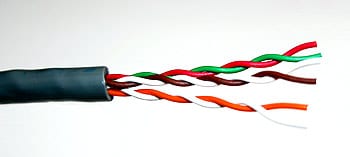Twisted Pair Testing
Twisted pairs can be a hassle to build and test but they are necessary in some cables and harnesses. Testing twisted pairs may be confusing at times, but there are tricks to use that will help you achieve accurate results and ensure twisted pairs function correctly in your cable.

What are twisted pairs?
A current running through a wire generates a magnetic field. When the current changes, the magnetic field also changes. These changes can create currents and interfere with signals in surrounding wires. This interference is called cross-talk and it occurs between wires even when the wires are separated by insulation. The longer the cables and the higher the frequency signals, the more cross-talk occurs.
Generally the purpose of twisted pairs is to minimize cross-talk to and from other wires. A twisted pair is two wires wound together. Signals are sent down the wires such that when one wire in the pair becomes positive the other wire becomes negative by the same amount. Neighboring wires close to this pair will be affected by cross-talk equal to the sum of the two signals. So if this sum is zero (or nearly zero) then the effects of cross-talk are eliminated. This makes the signals sent down a cable cleaner because most electrical noise entering into and/or radiating from the cable can be removed.
Split pair error
Conventional tests such as continuity, resistance, and insulation tests will not sufficiently find all errors associated with twisted pairs. One type of error undetectable by conventional test methods is called a split pair. A split pair error occurs when one wire from each of two different pairs gets swapped identically on both ends of the cable. The result is a cable that will pass a standard continuity test, but will have serious cross-talk problems, and will most likely not perform adequately at specified data rates.

Tips for testing twisted pairs
The nature of twisted pairs can make them difficult to test. If the wires are too short or the quality of the twisted pairs is poor, you will need to compensate for the limitations. The following are tips to try when testing twisted pairs.
Use short interface cables
- The total length of interface cables (both sides) must be less than 1/3 of the total length of the cable under test. If you cannot avoid longer interface cables, or if you cannot maintain the same twisted pair pattern in your interface cable, a coaxial cable can be used instead.
- To use coaxial cable – all twisted pair points tested must be connected through an individual coaxial cable center conductor, and the shields of all the coax wires must be connected together and grounded to the tester chassis.
To shorten interface cables – test directly on Cirris adapter cards plugged into the tester.
Adjust for poor-quality
Any of the following conditions can exist in poor-quality twisted pair cabling:
- Each pair is not shielded
- The wires have less than 2 twists per inch
There is a general twisting lay to the bundle every foot for the length of the cable.
For best results with this type of poor-quality cable, keep all adapting cables short and use high quality twisted pair wiring or shielded wiring in your fixturing.
Add length for testing
If a twisted pair wire is too short to test accurately, make the twisted pairs twice as long as needed and test from both ends (only one end is required for a twisted pair test). Then cut the cable in half. The result will be two cables which have both been through twisted pair testing and only need continuity testing after terminating the second end.
You can also test your cable while it is still attached to the reel. Ensure one end of the spool of cable is terminated. After testing for twisted pairs cut the cable to length from the reel and terminate the other end. Using a standard continuity test will now guarantee that the cable has been pinned correctly. The additional length of the cable on the reel will also give the tester more margin while measuring for the presence of twisted pairs and will produce more repeatable results.
Cirris testers that test twisted pairs
Certain Cirris testers can perform twisted pair testing by checking that specific wires behave as twisted pairs. This type of test is available on the following Cirris testers:
- CH2
- Easy-Touch® Pro
- 4250
These testers are able to add a specific test instruction to the test program that will measure cross-talk and help find split pairs.
A note for testing twisted pairs
A Cirris twisted pair test is not a substitute for CAT5, CAT6, or other types of RF testing and performance certification. A Cirris twisted pair test only ensures that the quality of the twists is consistent, and that the cable is free of split pairs. To check performance characteristics (propagation, impedance, frequency, cross-talk, packet loss) you will need a different type of instrument.
Examples:
http://www.flukenetworks.com/datacom-cabling
http://www.idealindustries.ca/products/prodSelect.php?prodId=LanTEK2

